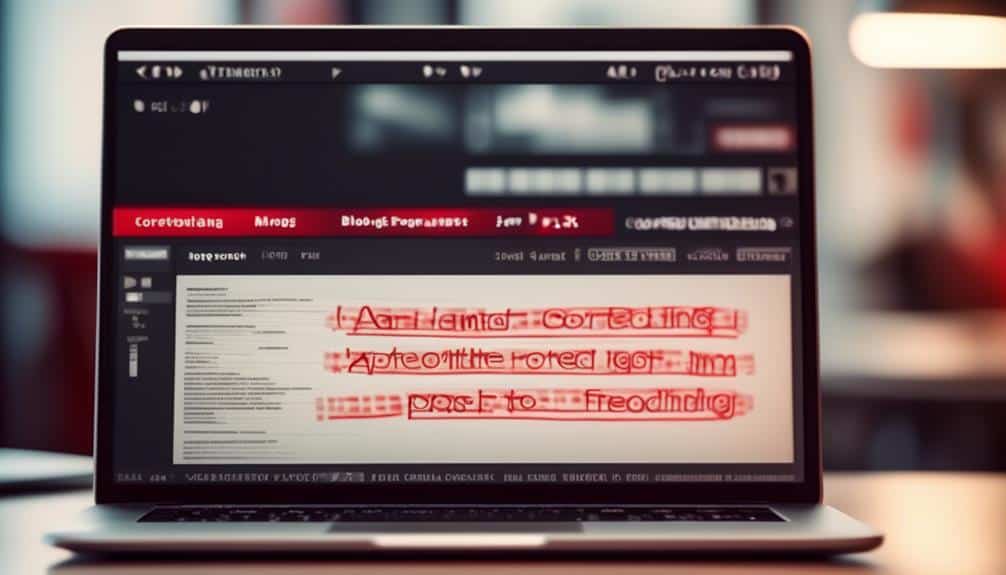He Final Touch: Mastering the Art of Proofreading Your Blog Posts
Perfecting your blog posts is a pivotal part of your writing process. But have you truly honed the skill of the final touch?
As a blogger, you strive for polished content that resonates with your audience. Proofreading plays a crucial role in achieving that goal. However, even the most seasoned writers can overlook subtle errors that detract from their message.
How can you ensure that your blog posts are pristine and professional before they go live?
Key Takeaways
- Mastering proofreading elevates the professionalism of blog content.
- Utilize online tools like grammar checkers and seek feedback from others for efficient proofreading.
- Developing a comprehensive proofreading checklist ensures credibility and accuracy in blog posts.
- Techniques such as paying attention to common mistakes and implementing effective editing strategies are crucial for error-free blog posts.
Importance of Proofreading

Mastering the art of proofreading is crucial for ensuring your blog posts are polished and error-free, elevating the professionalism of your content.
The proofreading process involves a meticulous review of your writing to catch any grammatical, spelling, or punctuation errors that may have slipped through the cracks. To enhance your proofreading techniques, start by taking a break after writing to give yourself fresh eyes when you come back to review your work.
Reading your content aloud can also help you identify awkward phrasing or inconsistencies that need to be addressed. Additionally, using online tools like grammar checkers can assist in flagging potential mistakes that you may have overlooked.
Common Proofreading Mistakes
To avoid common proofreading mistakes, it's essential to pay close attention to detail and thoroughly review your blog posts for errors. Punctuation pitfalls can easily sneak into your writing, so be vigilant. Check for missing commas, misplaced apostrophes, and overused exclamation marks. These errors can disrupt the flow of your content and detract from your message.
Grammar gaffes are another common stumbling block. Keep an eye out for subject-verb agreement, verb tenses, and pronoun usage. Incorrect grammar can make your writing confusing and less professional.
When proofreading, take the time to read your blog posts aloud. This simple technique can help you catch errors that might've slipped by when reading silently. Additionally, consider using online tools or asking a friend to review your work for a fresh perspective. By being meticulous in your proofreading process, you can ensure that your blog posts are polished and error-free.
Tools for Efficient Proofreading

For efficient proofreading, utilize online tools and seek feedback from others to enhance the quality of your blog posts. Grammar checkers are valuable resources that can help you catch common mistakes such as spelling errors, punctuation issues, and grammatical inconsistencies. These tools can provide instant feedback and suggestions for improvement, saving you time and ensuring a polished final piece.
Online resources offer a wide range of services to aid in proofreading. From grammar and spell checkers to writing style analysis tools, these platforms can help you refine your writing and make it more engaging for your audience. By leveraging these resources, you can elevate the quality of your blog posts and establish a professional image online.
In addition to using online tools, don't underestimate the power of seeking feedback from others. Whether it's a fellow blogger, a friend, or a professional editor, outside perspectives can offer valuable insights and help you identify blind spots in your writing. Embrace constructive criticism as a means to grow and improve your proofreading skills.
Developing a Proofreading Checklist
Craft a meticulous proofreading checklist to ensure thorough review of your blog posts. Developing an effective proofreading checklist can significantly enhance the quality of your writing. Here are four key items to include in your checklist:
- Spelling and Grammar: Double-check for any typos, misspelled words, or grammatical errors. These mistakes can detract from your credibility as a writer.
- Consistency: Ensure consistency in formatting, punctuation, and writing style throughout your blog post. Inconsistencies can disrupt the flow of your content.
- Clarity and Coherence: Confirm that your ideas are presented logically and cohesively. Check for any unclear or ambiguous statements that may confuse your readers.
- Fact-Checking: Verify the accuracy of any information, statistics, or quotes included in your blog post. Misinformation can damage your reputation as a reliable source of content.
Techniques for Spotting Errors

When proofreading your blog posts, it's crucial to pay attention to common mistakes like grammar errors and typos.
By implementing effective editing strategies, you can enhance the quality of your content and ensure its accuracy.
Spotting errors early on will help you maintain a professional and polished blog.
Common Proofreading Mistakes
To improve your proofreading skills, focus on recognizing common mistakes that can easily slip by unnoticed in your blog posts. Here are some key areas to watch out for:
- Grammar check: Ensure subject-verb agreement and watch out for commonly confused words.
- Punctuation errors: Check for missing commas, overused exclamation points, or incorrect apostrophe usage.
- Spelling mistakes: Look out for commonly misspelled words or typos that spell check might miss.
- Consistency in formatting: Ensure headings, fonts, and spacing are uniform throughout your post to maintain a professional appearance.
Effective Editing Strategies
Spotting errors in your blog posts can be significantly enhanced by implementing effective editing strategies that focus on meticulous attention to detail and precision. When editing your work, pay close attention to grammar rules and style choices to ensure a polished final piece. Utilize the table below as a quick reference guide to help you spot common errors and make necessary corrections:
| Common Error | Editing Strategy |
|---|---|
| Subject-Verb Agreement | Read sentences aloud to check for agreement. |
| Punctuation Mistakes | Use online tools like Grammarly for punctuation checks. |
| Word Repetition | Utilize synonyms or rephrase sentences for variety. |
The Role of Peer Review
When it comes to perfecting your blog posts, peer review plays a crucial role. It offers you the advantage of receiving constructive feedback from others who can provide fresh perspectives.
This collaborative review process helps catch errors, enhance clarity, and elevate the overall quality of your content.
Peer Editing Benefits
Engaging in peer editing offers bloggers invaluable insights into enhancing the quality of their work through collaborative critique and feedback. When you participate in peer editing, you open yourself up to a world of improvement possibilities. Here are four reasons why peer editing can benefit you:
- Fresh Perspective: Peers can offer a fresh set of eyes on your work, catching mistakes or inconsistencies you might've missed.
- Knowledge Expansion: Through feedback exchange, you can learn new writing techniques or styles that can elevate your content.
- Building Trust: Collaborating with peers fosters a sense of community and trust, creating a supportive environment for growth.
- Enhanced Skills: By actively engaging in peer editing, you sharpen your own editing skills and become more adept at critiquing your own work.
Collaborative Review Process
To enhance the quality of your blog posts, incorporating a collaborative review process, such as peer review, is essential for receiving valuable feedback and constructive criticism. Team collaboration plays a crucial role in refining your content.
When engaging in a peer review process, you open the door to a diverse range of perspectives. Embrace the opportunity to have your work scrutinized by others; this scrutiny can lead to significant improvements.
Review feedback from your peers can help you identify blind spots, inconsistencies, or areas that require clarification. The collaborative nature of this process fosters growth and development.
Tips for Proofreading Efficiency

To enhance your proofreading efficiency, establish a systematic approach for reviewing your blog posts. Here are four tips that will help you streamline your proofreading process and ensure your content is error-free:
- Utilize Grammar Check Tools: Take advantage of grammar check tools like Grammarly or Hemingway to catch any spelling, grammar, or punctuation errors you might've missed during your initial review.
- Create a Revision Checklist: Develop a checklist of common mistakes you tend to make, such as using passive voice or repetitive words, and use it to guide your proofreading process.
- Take Breaks Between Revisions: Give yourself some time between revisions to refresh your mind and come back with a new perspective. This will help you catch errors that you might've overlooked before.
- Read Aloud: Reading your blog post aloud can help you identify awkward phrasings, missing words, or grammatical mistakes that may not be apparent when reading silently.
Final Steps Before Publishing
Before moving forward with publishing your blog post, ensure that you have meticulously reviewed and finalized all content details. Paying attention to grammar rules and writing style is crucial in this final stage. Here is a simple guide to help you ensure your post is ready for the world to see:
| Grammar Rules | Writing Style |
|---|---|
| Check for subject-verb agreement. | Ensure your tone is consistent throughout. |
| Look out for punctuation errors. | Use active voice to keep your writing engaging. |
| Verify proper word usage. | Eliminate unnecessary words to make your message clear. |
| Review verb tense consistency. | Check for smooth transitions between paragraphs. |
| Watch out for spelling mistakes. | Utilize descriptive language to paint a vivid picture for your readers. |
Frequently Asked Questions
How Can I Effectively Handle Feedback From Peer Reviews During the Proofreading Process?
When handling criticism from peer reviews during proofreading, remember to stay open-minded and considerate. Embrace peer support as a valuable resource for improvement. Constructive feedback can enhance your work and help you grow as a writer.
What Are Some Common Proofreading Mistakes to Watch Out for Specifically in Blog Posts?
Before publishing your blog posts, remember to grammar check and watch out for common punctuation errors. These mistakes can detract from your message. Stay vigilant and give your content the final polish it deserves.
Can You Provide Examples of Tools for Efficient Proofreading That Are Specifically Tailored for Blog Content?
When proofreading blog content, it's crucial to utilize tools like grammar checkers and online editing services. These resources are tailored for blog content, offering efficient ways to catch errors and enhance the overall quality of your posts.
What Are Some Techniques for Spotting Errors That Are Often Overlooked by Bloggers?
When proofreading blog posts, don't skip the nitty-gritty details. Pay attention to grammar tips like subject-verb agreement and common punctuation errors such as misplaced commas. Your posts will shine with a little extra care.
How Can I Ensure Consistency in My Writing Style and Tone Throughout My Blog Posts During the Proofreading Process?
To ensure writing consistency and tone control in your blog posts, read aloud for flow, check for repetitive phrases, and use tools like Grammarly. Consistency keeps readers engaged, while tone control sets the right mood.
Conclusion
In conclusion, mastering the art of proofreading is essential for creating polished and professional blog posts. By paying attention to detail, using tools for efficiency, and developing a checklist, you can spot errors and ensure a flawless final product.
Remember the importance of peer review and follow these tips for proofreading efficiency before publishing your work. With these final steps, you can take your blog posts to the next level and impress your readers with your attention to detail and precision.








